The landscapes of Maurice Genevoix
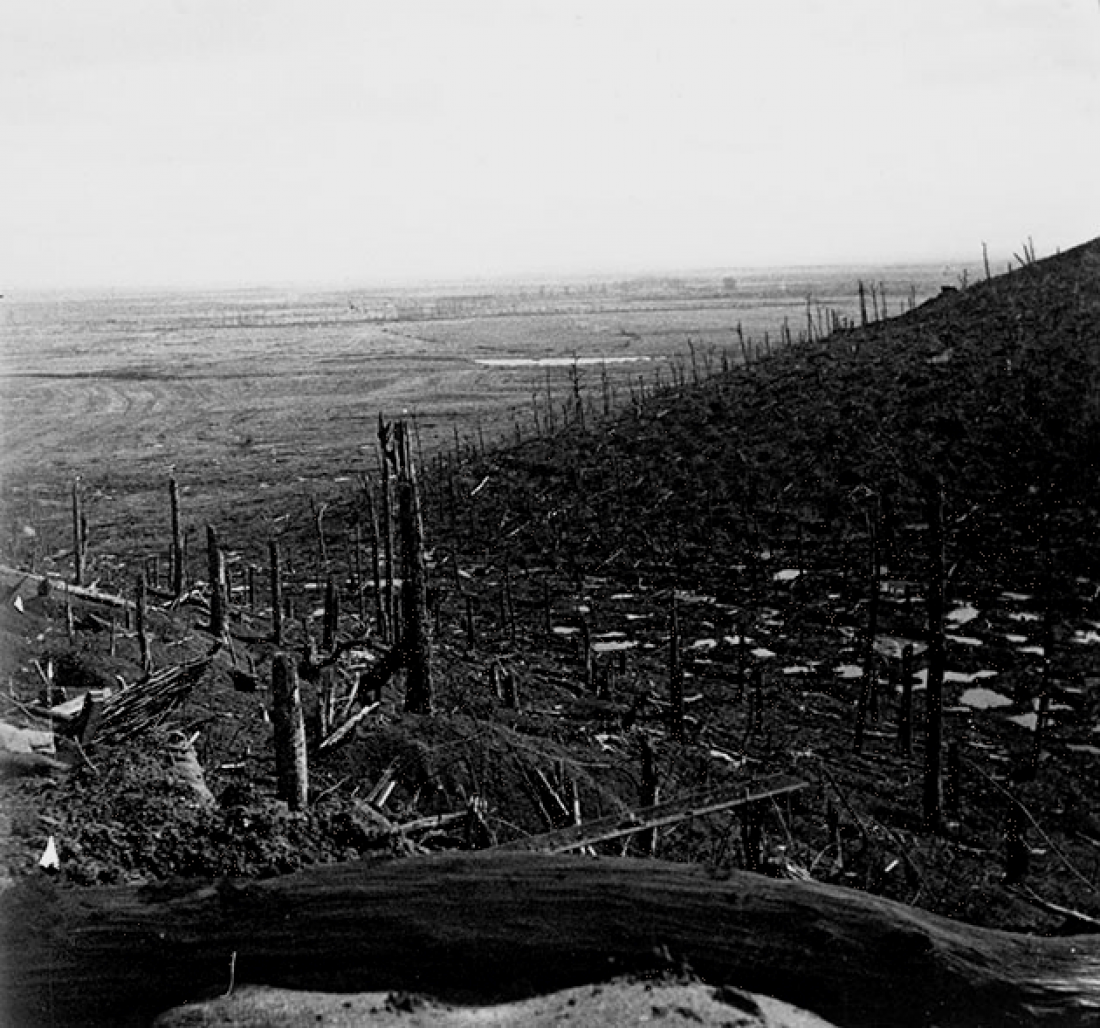
A witness to the suffering of men and animals in the First World War, writer Maurice Genevoix was also a sensitive witness to the destruction of the beautiful landscape of Les Éparges and its subsequent resurrection in peacetime. The landscape of war began as a war on the landscape, to become a landscape of remembrance.
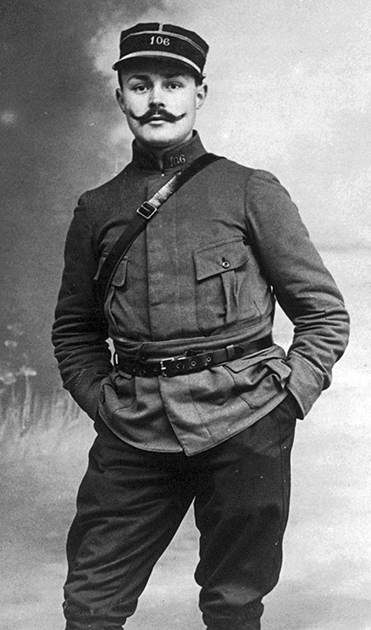
Private Maurice Genevoix in 1914. © ECPAD / Défense
“Porchon! Come and see this, it’s lovely! [...] Before us, the Longeau Valley opens out between two chains of perfectly curved hills. To the left, the summits undulate on the edge of the sky, a powerful line softened by the velvet trees...” (Ceux de 14, Maurice Genevoix.)
Maurice Genevoix kept a handful photographs from his war in the Meuse, from late August 1914 to late April 1915, most of them taken by Lagarrigue, the battalion doctor. They are group portraits, some of them showing the future writer, before a barn, in a village street, at the entrance to a shelter, on a forest road. One of the pictures, in the style of the paintings of Caspar David Friedrich, shows two soldiers with their backs to the camera, in sparse undergrowth, in winter. Standing side by side, the two men are looking straight ahead, at the dark shape of a long ridge beneath the grey sky. This photograph was taken on 16 January 1915. We know that from the account in Ceux de 14, which is corroborated by his comrade Second Lieutenant Robert Porchon’s memoir, Carnet de route. The figures are those of Porchon and Rebière, a second lieutenant newly assigned to the 106th Infantry Regiment. The more experienced officer, at the front from the beginning, is showing the novice his way around the sector, the location of the French and German positions. The ridge on which their gaze is fixed is that of Les Éparges. Porchon would be killed there on 19 February; Rebière, on 7 April.
FROM LOIRET TO THE MEUSE
Genevoix wrote almost as often about the landscapes of the Meuse as those of his native Loiret. The great French river was where his childhood had begun; the river in Lorraine was where it ended. The Loire Valley, flanked by the forests of Sologne and Orléans, was the setting for his novels; the Meuse Valley and its hillsides was the scene of the war and his account of it.
A conscientious officer, Genevoix used scraps of paper and pencil to make his sketches in cavalier perspective of the enemy trenches and the presumed positions of their machine guns and artillery, technical drawings that were part of his new métier. He saved the outpourings of his old love of the landscape for his journal, written when he was at rest or in the second-line bunkers. It mingled with his taste for literature rooted in the provinces. He enjoyed capturing the essence of a horizon at dawn, a snow-covered plain, a solitary tree, a village around its church tower. He exposed their singularities in rich, inventive language full of imagery. His correspondence with Paul Dupuy, secretary-general of the École Normale Supérieure, contains many such literary miniatures, which reveal the talent of a born writer. Particularly polished are those pages of his journal which he addressed to Dupuy in December
1914: “From high up, we look down over an immense rounded valley: at the foot of the slope are dark woods with great bright enclaves of harvest-ripe crops. To the right, a road bends sharply between two rows of trees; before us, another road, at right angles to the first, cuts a brutal line across the rainbow richness of the fields. Down in the valley is the village of Dannevoux, white beneath the leaves. And in the distance, beyond the concealed Meuse, lies a chain of blue hills.” (Maurice Genevoix, Paul Dupuy - Correspondance, 28 août 1914 - 30 avril 1915, Éditions de La Table Ronde, p. 294) This was his first contact with the front, on the right bank of the Meuse, upstream of Verdun, the day after he joined his regiment.
THE BIRTH OF A LANDSCAPE WRITER
Following instructions and subject to censorship, Genevoix did not specify his location, the positions occupied by his unit, in his letters, but his descriptions of the countryside, terrain, plants and type of soil were so evocative that his correspondent, a geography lecturer and esteemed colleague of Paul Vidal de La Blache, immediately identified the Verdun area and the profile of cuestas of this part of Lorraine. As early as October, from the École Normale where he lived, he pinpointed on a map the position of the 106th Infantry Regiment, then followed its fortunes in communiqués that mentioned Les Éparges.
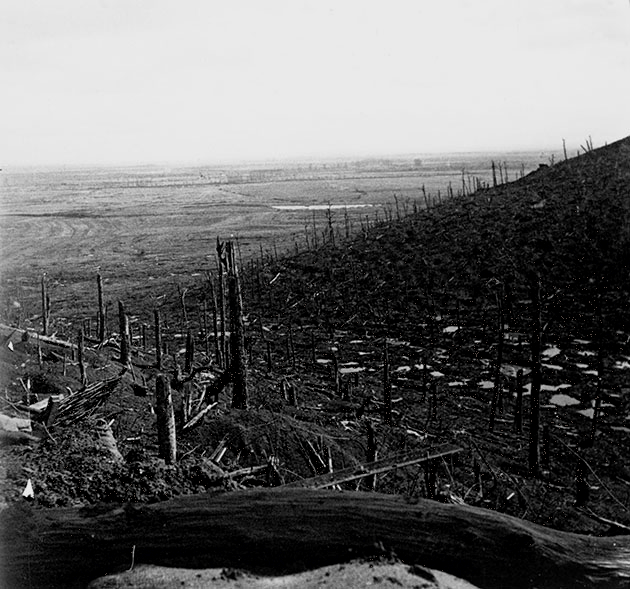
La Fragoulle Ravine, also known as ‘Death Ravine’, Les Éparges (Meuse), 1917.
Detail from a stereograph by private Maurice Létang of the 53rd Infantry Regiment. © M. Létang / Roger-Viollet
Genevoix’s landscape writing, in the tradition of Maupassant and Flaubert, which was to blossom in his novels about nature and people, was already at its best in his war writings. Clearly, this had a lot to do with the skill of this exceptionally gifted young man. But it also had to do with circumstances. The fighting, the danger, the rarity of a life so far removed from the one he had left behind a few weeks before as a student in Paris, hastened the discovery of his calling. Proximity to death and the chances of meeting an early grave created a sense of urgency to tell his story, and contributed a sharpness to his writing. The quest for efficiency, coupled with a kind of modesty, led to an economy of words and effects.
According to the command’s battle plans, the 106th Infantry Regiment, a cover unit stationed at Châlons-sur-Marne, would move to the Longwy sector, in Lorraine, on the first day of mobilisation, to confront the German troops in the Saar. When war was declared, it was in position and, after some skirmishes, took part in the Battle of the Frontiers. In late August, it retreated to the north of Verdun, which it defended. That is where, on 27 August, Second Lieutenant Genevoix joined the regiment, with reinforcements sent to replace heavy losses. At the end of the Battle of the Marne, it resisted the enemy advance between Bar-le-Duc and Verdun, first to the west, victoriously, then to the east, when the Bavarian divisions from Metz appeared by surprise in the Woëvre, in late September. The fighting which halted their advance took place on the wooded massif of the Côtes de Meuse, on the Tranchée de Calonne, the long road through undergrowth where Alain-Fournier was killed, and where Genevoix himself would be seriously wounded seven months later.
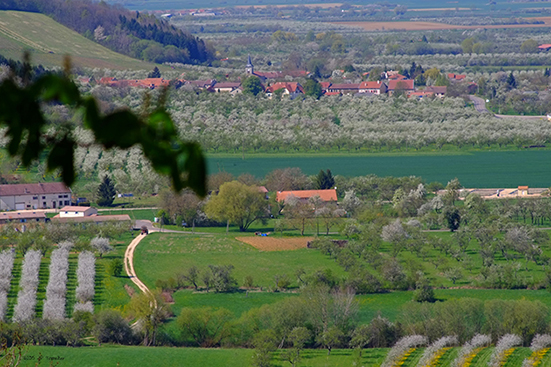
View of the village of Viéville-sous-les-Côtes, from Hattonchâtel, Meuse, Lorraine. © J-P. Tonnelier
Of the promontories overlooking the area, Les Éparges was the highest. The Germans were entrenched there, having fortified it in early autumn 1914. This was the objective given to Genevoix’s regiment, as part of Joffre’s plan to retake the high ground in Lorraine, the Vosges and Artois, and relieve the Russian front by targeting the German divisions from the west. It would take two months to achieve, at a cost of countless dead and wounded on both sides. After a few days, the losses were so great that Second Lieutenant Genevoix and his few remaining men felt like they were hauling themselves over piles of corpses.
When you cast your gaze over this bit of country, patiently, stubbornly recovered by farmers, everything expresses labour, necessity, movement and the grace of the seasons. You must walk in order to find, in the midst of a group of fir trees, the white crosses of the Trottoir cemetery and, higher up, under the cover of trees, small commemorative monuments among the mine craters. You need to have read Ceux de 14 to imagine the hell experienced by the men on the hill. Yet no one today is able to see this beautiful landscape of Les Éparges, the Woëvre plain and the Côtes de Moselle slopes in the distance through the eyes of the survivors returning to the place where their youth was extinguished.
“LANDSCAPES RESTORED TO PEACE”
Maurice Genevoix came back often to Les Éparges. Some residents of villages in the sector - Saint-Rémy-la-Calonne, Rupt-en-Woëvre, Fresnes-en-Woëvre, Mont-sous-les-Côtes, Trésauvaux, Mouilly - recall a friendly old man, short, slim, straight-backed and meticulously well turned-out, who would stroll around after the ceremonies. He would walk along the lanes, paths and tracks which, aged 24, he had walked in all directions, alone or with his section. He saw again the houses where he had been billeted, the churches and cemeteries of the funeral services, the roads, Rue Mazel in Verdun. In Trente mille jours (Thirty thousand days), written months before his death, in his Bestiaires (Bestiaries) and in many of his occasional texts, he told of his pleasure at seeing the landscapes of the Côtes de Meuse restored to peace and agriculture. The cherry trees in bloom in April, the red leaves of the vine-covered slopes in October, the down of the woodlands on the hills, the shimmering Woëvre plain in summer: this landscape which he got to know for a few days in the summer and autumn of 1914, before the bombardments changed it beyond recognition.
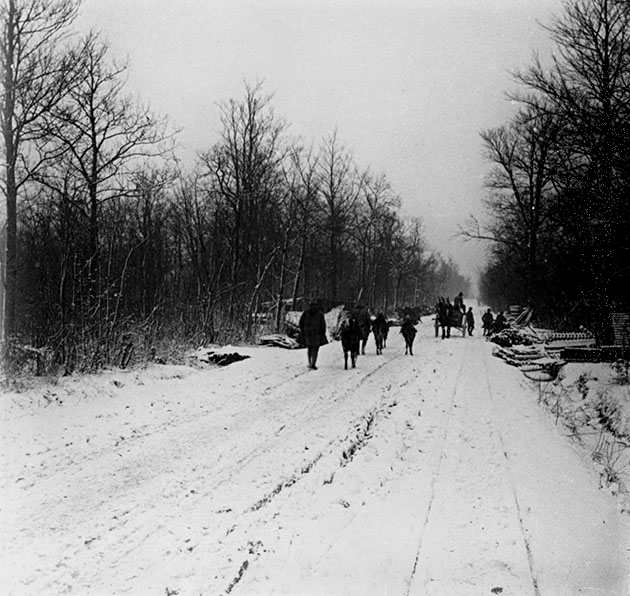
The trench of Calonne (Meuse), 1917. Detail from a stereograph by private Maurice Létang of the 53rd Infantry Regiment. © M. Létang / Roger-Viollet
Like many veterans who visit the battlefields, he sometimes took his wife and daughters, especially Sylvie. Born in May 1944, Sylvie takes her name from the first flower which her father saw sprouting up from the razed, churned-up earth, devastated by showers of shells, in the first days of spring 1915: the wood anemone, or anémone sylvie, in French.
Immediately after the armistice, the scrap metal was recovered, the trenches and saps filled in, and the dead were buried in cemeteries. Then the villages were rebuilt and the forests, cherry trees and vineyards replanted. The landscape was restored to its former state and, as if the war had never taken place, the two shores of peace once again closed over its beauty.
Maurice Genevoix loved driving. He arrived by car from Paris, passing through Brie and Champagne, and crossing the Argonne massif, and through his windscreen he found the wide Meuse Valley as he had left it, the slow river watering its grasses. Here, the dizzying pace of human life seemed to loosen its grip. By a stone bridge, among the poplars, the cows drank from the river. Away from the high winter waters sprawled the villages, long, narrow ribbons of faded tiles at the juncture of the Côtes. The Côtes began here, with the forest penetrated by the road. The light dimmed, soft and green, tinged with gold. Once across the Longeau, he was met by ghosts. Young men’s faces appeared in the restored beech wood, their voices, laughter, calls and shouts murmuring in the branches. “Here, on New Year’s Eve, Soriot and Captain Maignan were killed; further up, Trelan, Ledru and Jubier were buried; and over there is where Hirsch was seen for the last time. I was wounded here, and Porchon over there.” At the end of the path, at the tip of Les Éparges, sunk in the earth among the arable fields and thickets, the lakes of Woëvre shone brighter than ever beneath his gaze.
Michel Bernard - Writer

